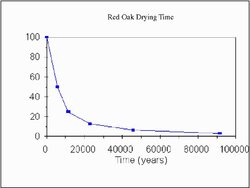Hi all,
Yep, I'm one of those fancy-schmancy MBA types and need to know the rate of seasoning
In all seriousness, I'm going to be scrounging for wood (with no truck) year round and will often be burning wood that hasn't been S/S for 12 solid months as recommended. I've been fortunate so far to have a huge store of Ash to start off with that has been fallen for 1 year, cut into rounds for 1 hot month, and S/S for 3 months.
Which makes me wonder - I'm guessing the vast majority of seasoning occurs right away and that it slows down greatly as less moisture remains. Does anyone know a typical seasoning curve?
For example: If Oak starts at 50% moisture, does it hit 30% by 4-6 months and then take another 6 months to drop to 20%? And then maybe take another 6 months to drop to 17%?
Does ash go from 30% to 20% in 3-4 months?
My natural way of thinking is that MOST woods will drop below the "30% minimum" mark by 6 months of seasoning, but I wasn't sure if moisture evaporation tends to be a heavy upfront curve or fairly linear.
Thoughts?
Joe
P.s. Please bear in mind that I know the ACTUAL results will be heavily influenced by conditions during those months, such as temperature, sunlight, and wind.
Yep, I'm one of those fancy-schmancy MBA types and need to know the rate of seasoning

In all seriousness, I'm going to be scrounging for wood (with no truck) year round and will often be burning wood that hasn't been S/S for 12 solid months as recommended. I've been fortunate so far to have a huge store of Ash to start off with that has been fallen for 1 year, cut into rounds for 1 hot month, and S/S for 3 months.
Which makes me wonder - I'm guessing the vast majority of seasoning occurs right away and that it slows down greatly as less moisture remains. Does anyone know a typical seasoning curve?
For example: If Oak starts at 50% moisture, does it hit 30% by 4-6 months and then take another 6 months to drop to 20%? And then maybe take another 6 months to drop to 17%?
Does ash go from 30% to 20% in 3-4 months?
My natural way of thinking is that MOST woods will drop below the "30% minimum" mark by 6 months of seasoning, but I wasn't sure if moisture evaporation tends to be a heavy upfront curve or fairly linear.
Thoughts?
Joe
P.s. Please bear in mind that I know the ACTUAL results will be heavily influenced by conditions during those months, such as temperature, sunlight, and wind.




